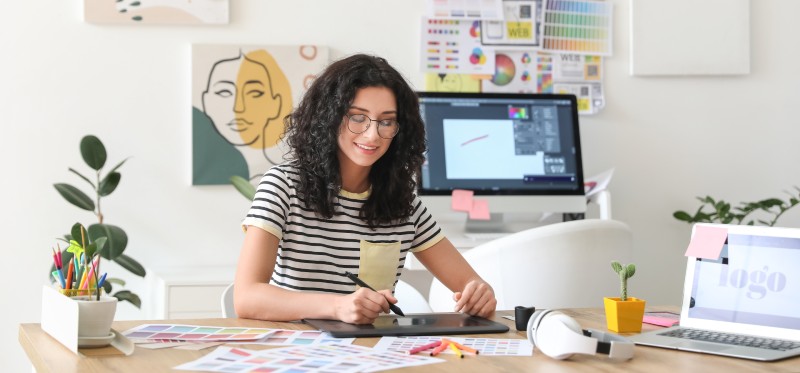
Introduction
If you are involved in running global marketing campaigns for your company, you will know the plethora of challenges that this can throw up.
Each market brings another layer of complexity, as you need to create multiple sets of assets, imagery and text that are localised to the needs of each market.
This is where you may find it advantageous to partner up with an international digital marketing agency with a design team with experience working with creatives for multiple markets.
Delegating the communication and marketing of your company to a team of creatives and designers can help reduce the workload for you – but it can also come with its own set of challenges, especially if you are not used to working with an external agency.
In this blog post, I will go through some tips and key topics to help you get the most out of your collaborations when working with global design teams from agencies like Webcertain.
1. Be clear about your project goals
Design teams need to know your goals and requirements before the start of any project. You will need to be clear and articulate your objectives. This will help the design team to understand your vision and expectations before the project starts.
Project goals provide a clear direction and purpose for the design team’s work. Elaborating on your project goals involves defining them in a way that is SMART (specific, measurable, achievable, relevant and time-limited). Here is a breakdown of each aspect:
- Specific: Clearly articulate what you want to accomplish. Avoid being vague or ambiguous with your goals. For example, instead of saying “improve the website”, a more clear and specific goal would be “redesign the website to enhance the user experience and increase conversion rates”.
- Measurable: Define how you will measure the success of the project. This could include metrics such as increased website traffic, higher click-through rates or more followers. Measurable goals allow you to track progress and evaluate the effectiveness of the design solutions.
- Achievable: Ensure that the goals are realistic. Consider the capabilities of the design team and the available budget when setting goals. Unrealistic goals can lead to frustration and a compromised outcome.
- Relevant: Align the project goals with your overall business objectives. Consider how achieving these goals will contribute to your company’s success and address specific needs or challenges that you have. This ensures that the design work has a meaningful impact on your organisation.
- Time-limited: Set a clear timeline for achieving the goals. Break down the project into milestones or phases and assign specific deadlines to keep everyone accountable. Additionally, consider prioritising your goals. If you have multiple objectives, determine which ones are most critical or time sensitive.
2. Provide a detailed project brief
Design teams have standard project briefs that can be shared with you to fill in. It is important that you share a comprehensive project brief, including as much information as possible on things like:
- your products or services, company vision, etc.
- your target audience(s)
- your channels, like pay-per-click or social networks
- the market(s) and language(s) required in the project
- any relevant information about competitors or previous campaigns
- your brand guidelines
- any dos and don’ts
- confidentiality agreements
The more information you share, the better the design team can understand your project needs and create appropriate solutions – maybe even coming up with solutions that you did not think of in the first instance.
3. Define and establish clear communication channels
It is very important to establish clear communication channels. Determine your preferred modes of communication like email, project management and design reviewing tools, and video conferencing apps.
It is also important to ensure that the design team has direct access to key stakeholders and decision-makers to avoid any gaps in communication.
When working with design teams, it is important to agree and set up a file-sharing mechanism. Design projects often require working with large files. Safety and confidentiality are important when sharing internal corporate documents and files. Take this seriously.
4. Share all relevant resources in the highest resolution possible
In order to do as good a job as possible, the design team will need you to provide the best-quality resources available. Share any documents and files that are required for the project. However, make sure not to over-share, as sharing documents with extraneous information that is not relevant to the project may confuse the design team and lead to mistakes or misunderstandings of what is expected. Take your time to prepare these documents, as in the end, this will save you a lot of time as it will help to avoid delays that could lead to the deadline being missed.
- Images: The design team should be given any images and illustrations at the highest quality and resolution possible. Always use vector files for your logos and illustrations. This will make a huge difference when rescaling and resizing designs for other uses.
- Texts: Written content should already have been proofread. Design teams do not typically proofread texts. This is important when working with global projects. You will need to provide all the translated texts, with everything already checked by a proofreader for each language.
- Working with multiple languages: If you have a global project, it can be very challenging to review all the languages. You may not have translators and proofreaders for all the required languages in-house. Outsource this, if needed. Your agency may have a translation and/or proofreading department that can help, so do not be afraid to enquire about this.
- Cultural insights: When working with global campaigns, it is necessary to have a team of translators and copywriters that will give your project that extra punch to connect with your target audience. Connect that team with the design team for outstanding results.
- Brand guidelines: If you have a brand guidelines document, it is very important to share it with the design team, so they can follow your guidelines. If you do not have a brand guidelines document, you should share whatever information you can regarding how the design team should work with your brand name, logo, colours, etc.
- Video assets: When working with video, design teams will ask you for raw files, or unedited clips at the highest resolution possible. Make sure to provide these, to avoid videos looking blurry or having unwanted elements that are almost impossible to remove.
- Platform access: There may be projects where you need to provide access to your platforms to the design team. Do not be afraid to do this. Your contract and confidentiality agreements will protect you from any unwanted issues.
5. Provide feedback and embrace teamwork
Working with the design team will be an exercise in teamwork. Embrace it!
- Encourage collaboration and feedback: Work as a team. Always ask the design team to share their concept arts, wireframes, prototypes or mock-ups early in the project. This will accelerate the process and will help to avoid mistakes.
- Review and provide constructive feedback promptly: This will keep the project on track. Collaboration is key, so be open to the design team’s suggestions and ideas and maintain a constructive dialogue throughout the process.
- Keep the right balance between guidance and creative freedom: Whilst it is important to communicate your requirements clearly, you should also give the design team the freedom to explore creative solutions. Trust their expertise and experience and allow them to propose innovative ideas.
- Connect the project teams: When working with global projects, connect all the teams involved. Translators, proofreaders and the design team will ideally be in touch with one another, so that the final arts can be reviewed by all parties involved.
- Be responsive and respect timelines: Design projects often have tight deadlines, so make sure you provide timely feedback and approvals. Avoid unnecessary delays in decision-making, as this can impact the project timeline and the design team’s workflow.
- Provide constructive feedback: When reviewing design concepts or deliverables, you need to provide specific and actionable feedback. Clearly communicate what you like, what needs improvement, and any changes or adjustments you require. This will help the design team to understand your preferences and make all the necessary revisions efficiently.
- Show appreciation: And finally, recognise and appreciate the efforts of the design team! They are working hard to provide the best visuals possible for your global campaigns. Providing positive feedback and acknowledging their contributions can help to build a strong and long-term working relationship.
Conclusion
I hope this blog post has been a useful overview of how best to work with an external design team when running your global campaigns, to get the best possible results out of the collaboration.
By being clear about your project goals, providing a detailed project brief, defining and establishing clear communication channels, sharing all relevant resources in the highest resolution possible, and providing feedback and embracing teamwork, you can help to create a harmonious working relationship that results in you getting the localised visual assets you need to run your global marketing campaigns smoothly.
Here at Webcertain, we have our very own design team who are specialists in international campaigns, so if you are looking for an international design agency to partner with, just get in touch today and we will be happy to help!







